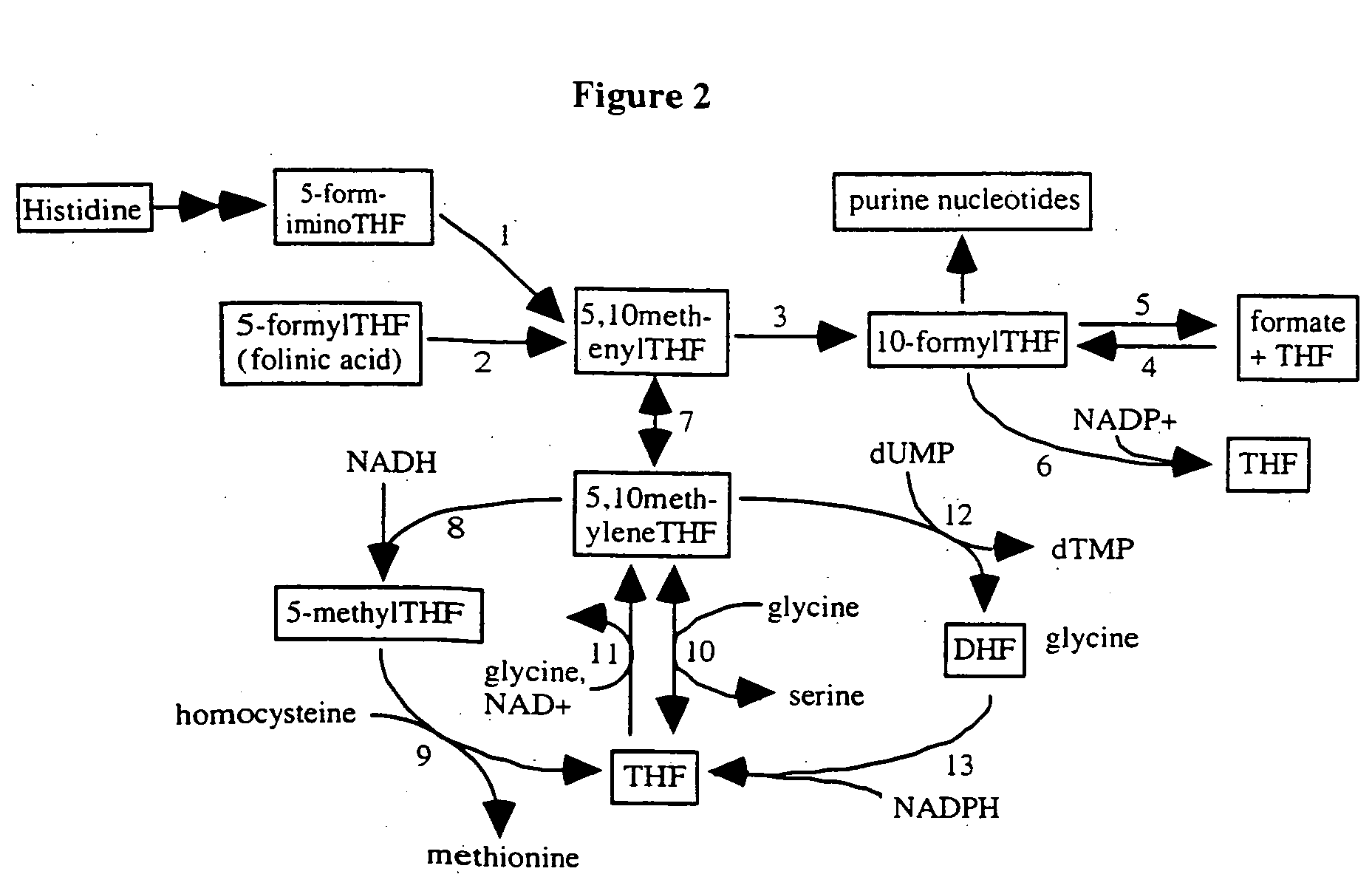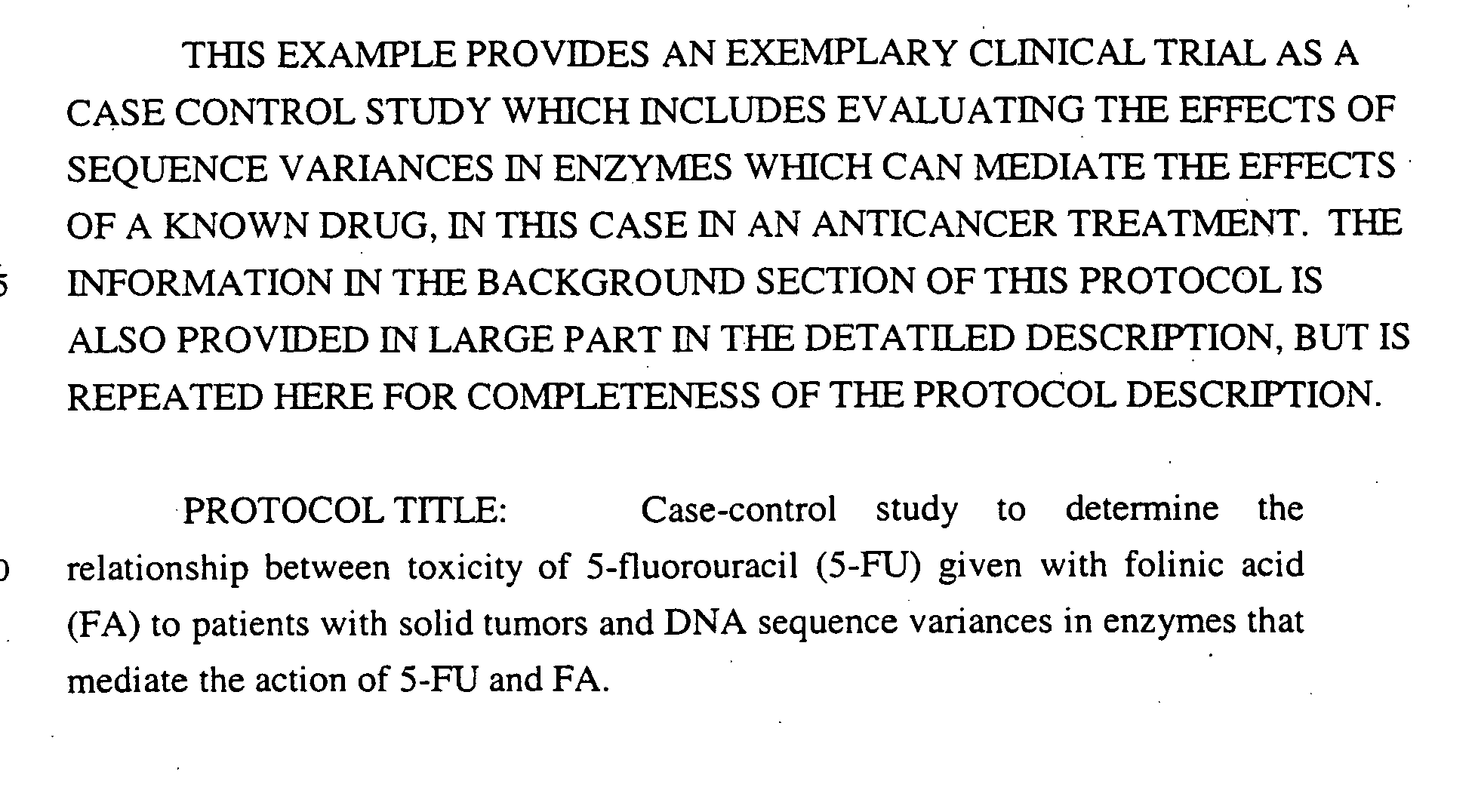Gene sequence variances in genes related to folate metabolism having utility in determining the treatment of disease
a gene and gene sequence technology, applied in the field of mammalian therapeutics and the selection of therapeutic regimens, can solve the problems of ineffective or not well tolerated in another individual, waste of cost and time, and significant worsening of patient's condition, so as to achieve more effective treatment and affect the efficacy or safety of the drug
- Summary
- Abstract
- Description
- Claims
- Application Information
AI Technical Summary
Benefits of technology
Problems solved by technology
Method used
Image
Examples
example 1
Gene Identification
Metabolic Pathways that Affect 5-FU / FA Action
[0514] The biochemical pathways of 5-FU metabolism have been studied extensively. Likewise, folate metabolism has been well investigated and the enzymes that form and consume 5,10-methylenetetrahydrofolate are well known. The principal metabolic pathways that influence the pharmacologic action of 5-FU are summarized below.
De Novo and Salvage Routes of Pyrimidine Nucleotide Formation (5-FU Anabolism) and Inhibition of Thymidylate Synthase
[0515] 5-FU is a biologically inactive pyrimidine analog which must be phosphorylated and ribosylated to the nucleoside analog fluorodeoxyuridine monophosphate (FdUMP) to have clinical activity. FdUMP formation can occur via several routes, summarized in FIG. 1. 5-FU may be converted by uridine phosphorylase to fluorouridine (FUdR; the reverse reaction is catalyzed by uridine nucleosidase) and then to fluorouridine monophosphate (FUMP) by uridine kinase, or FUMP may be formed from ...
example 2
Variance Identification—Variances in Genes That Can Affect 5-FU / FA Action
[0524] Exemplary genes related to modulation of the action of 5-FU / FA have been analyzed for genetic variation; thymidylate synthase, ribonucleotide reductase (M1 subunit only), dihydrofolate reductase and dihydropyrimidine dehydrogenase cDNAs. 36 unrelated individuals were screened using 6 SSCP conditions and DNA sequencing. Other investigators have identified variances in MTHFR, methionine synthase and folate receptor. These findings are summarized in Table 3.
TABLE 3Variation in Genes Which Modulate 5-FU / FA PharmacologyGene Name(GenbankVariancesHeterozygoteaccession no.)BaseRNAProteinFrequencyCommentsCytidine79T or Glys27glu>10%Deaminase(L27943)Dihydrofolate721T or A20%Reductase829C or T14%(J00140)RsaI RFLP23, 33, 43%3 allelesScrF126%RsaI RFLP32%unique RsaI RFLPDihydropyrimidinase1001A or Ggln334argrareAll found in patients with(D78011)1303G or Agly435argDHP deficiency203G or Cthr68arg1468G or Carg490thr10...
example 3
Relationship of Genes to Drug Response—5-flurouracil
[0527] 5-fluorouracil (5-FU) is a widely used chemotherapy drug. The effectiveness of 5-FU is potentiated by folinic acid (FA; generic name: leukovorin). The combination of 5-FU and FA is standard therapy for stage III / IV colon cancer. Patient responses to 5-FU and 5-FU / FA vary widely, ranging from complete remission of cancer to severe toxicity.
Clinical Use and Effectiveness of 5-FU and 5-FU / FA
[0528] 5-FU is a pyrimidine analog in clinical use since 1957. 5-FU is used in the standard treatment of gastrointestinal, breast and head and neck cancers. Clinical trials have also shown responses in cancer of the bladder, ovary, cervix, prostate and pancreas. The remainder of this discussion will concern colorectal cancer. 5-FU is used both in the adjuvant therapy of Dukes Stage B and C cancer and in the treatment of disseminated cancer. 5-FU alone produces partial remissions in 10-30% of advanced colorectal cancers, however only a fe...
PUM
| Property | Measurement | Unit |
|---|---|---|
| Volume | aaaaa | aaaaa |
| Fraction | aaaaa | aaaaa |
| Fraction | aaaaa | aaaaa |
Abstract
Description
Claims
Application Information
 Login to View More
Login to View More - R&D
- Intellectual Property
- Life Sciences
- Materials
- Tech Scout
- Unparalleled Data Quality
- Higher Quality Content
- 60% Fewer Hallucinations
Browse by: Latest US Patents, China's latest patents, Technical Efficacy Thesaurus, Application Domain, Technology Topic, Popular Technical Reports.
© 2025 PatSnap. All rights reserved.Legal|Privacy policy|Modern Slavery Act Transparency Statement|Sitemap|About US| Contact US: help@patsnap.com



